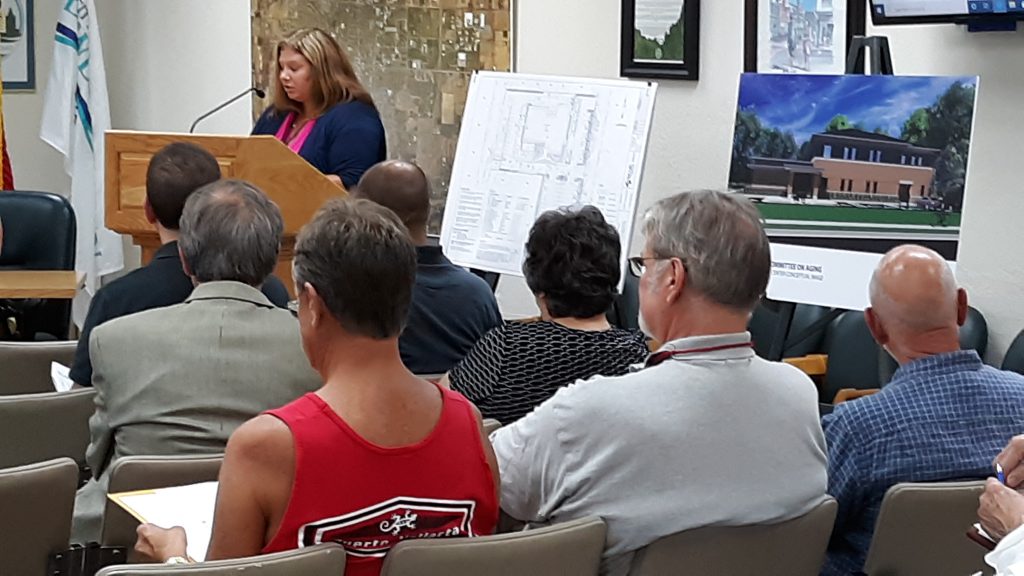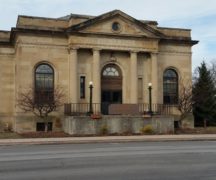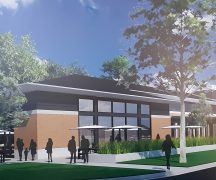By JAN LARSON McLAUGHLIN
BG Independent News
Normally it’s college students – not senior citizens – who cause anguish for city residents.
But as some neighbors of the new Wood County Senior Center welcome the facility, others are expecting problems from their new neighbor.
For nearly 90 minutes Tuesday evening, the Bowling Green Planning Commission listened as plans for the facility at 140 S. Grove St. were described, and neighbors expressed concerns about the proposal.
The 34,566-square-foot two-story senior center and adult day care facility will sit on 2.3 acres between South Grove and Buttonwood streets.
Top on the list of complaints were predictions of parking problems and flooding possibilities.
The Committee on Aging has requested a waiver on the required parking spaces. The city calculates parking requirements by the first floor footprint multiplied by the number of floors. In this case, that adds up to 179 spaces – which is far more than the site can accommodate. Currently, 82 spaces are planned for the site.
That is four times the parking spaces dedicated to the senior center at its current location on North Main Street.
But neighbor Jim Evans, who has lived on Buttonwood Avenue for more than 25 years, predicted that the overflow parking from the senior center would cause traffic congestion on Buttonwood and South Grove streets.
“The assurance of the senior center is really irrelevant,” he said.
Evans noted the deficiency of 97 parking spaces from the city requirements.
“I want to know where the other spaces are coming from,” he said.
Needing parking spaces will not only be local seniors, but also gerontology students from Bowling Green State University, who will be helping at the location.
“They are going to park wherever they want to,” Evans said, describing the congestion on the streets when the school district’s central administration building previously sat on the property.
“We have a right to peace and tranquility in our neighborhood,” he said.
Mike Duket, the architect for the site, said the Committee on Aging is working on an agreement with the neighboring First Presbyterian Church, to use its parking lot during peak hours.
Denise Niese, executive director of the senior center, explained there is frequent turnover in parking during the day.
“People don’t stay all day. Most people come for specific activities,” Niese said. “Senior centers are for active adults.”
The highest traffic can be expected from 11:15 a.m. to 1:30 p.m. on weekdays.
“That’s the lunch crowd,” averaging about 85 people, Niese said.
The senior center will have 14 staff on site, plus just two or three BGSU students a day. An estimated 10 seniors are transported to the site by a mini-bus each day.
One neighbor suggested that a bicycle rack be placed at the site, which Niese said was already in the plans.
The hours of operation at the senior center will be from 8 a.m. to 5 p.m., Mondays and Fridays; 8 a.m. to 7 p.m. on Tuesdays, Wednesdays and Thursdays; and Saturday hours may be added.
Though Niese added that the small Bridge group has been known to play until 11 p.m. some nights.

Municipal Administrator Lori Tretter reminded those in attendance that the city is acquiring an additional parking area near Wooster Green, which could be used by patrons of the senior center.
“We feel very comfortable with the plan that is presented here,” she said.
Tretter also noted that the city’s parking regulations are outdated, and in many cases require more parking spaces than are actually needed. That has led to a “sea of asphalt” in some areas of the city, she said.
Neighbors also offered other solutions if parking becomes an issue at the new senior center. Evans mentioned the possibility of parking permits, similar to those used in Chicago. And another neighbor suggested that parking spaces be painted on West Wooster Street, to remind drivers that parking is allowed there.
Some neighbors had concerns about landscape barriers between their properties and the senior center. East Wooster landowners Larry Nader, Jeff Snook and Ed O’Donnell were all satisfied with accommodations offered by the Committee on Aging.
However, Evans said he wanted “absolute clarification” about the fate of the existing chain link fence on his property line. The fence will remain, project designer Jeremey Cook said.
Evans also voiced concerns about the retention pond on the site leading to flooding of neighbors’ yards.
“All the neighbors are going to be dealing with a significant amount of water,” he said. “It will cause the backyards to flood.” Evans insisted that the retention pond should have a liner.
But Cook said the retention pond is designed for the purpose of preventing flooding. As for a liner, Cook said, “We do these all over the place, and I’ve never heard of that.”
Neighbor Forrest Blake, on Buttonwood, asked about the brightness of overnight lighting. He was told the LED overhead lamps will be directed downward so the light doesn’t exceed the senior center property.
Penny Evans-Meyer asked about the existing wall along Buttonwood, and three large trees on the property.
The wall will remain, but the trees will not. “We really tried to save all three of those trees,” Cook said, adding that more trees will be planted.
Many neighbors expressed positive feelings about the senior center moving next door.
“I’m really glad to see this happening. It’s great for our seniors,” said Mark Heider, who lives on West Wooster. “I’m hoping it won’t increase traffic too much.”
Snook agreed.
“We’re glad it will be a new addition to our neighborhood. I’m sure it will be well maintained,” he said.
And Nader was comforted after seeing the plans.
“I’m quite pleased with what I see,” he said.
But Evans-Meyer questioned whether or not the senior center knew how to be a good neighbor. She noted the posting of “private property signs” when the Committee on Aging purchased the property.
Niese explained those signs were put up at the suggestion of the Committee on Aging’s attorney, to avoid liability if there were injuries on the property.
Evans noted the current senior center location in a primarily business area on North Main Street.
“Now you’re moving into a residential neighborhood. The very first thing you did was put up those nasty signs,” he said.
Niese responded that the senior center knows how to be neighborly, and held multiple public meetings to get input on the new facility.
Evans said those meetings were not adequate, and suggested the Committee on Aging should set up a residential committee to deal with neighbor concerns on an ongoing basis.
“I think we like our old neighborhood,” Evans-Meyer said, noting the number of neighbors present at the public hearing Tuesday evening.
Planning commission member Erica Sleek spoke of the value of having the senior center maintain a downtown presence.
“We don’t want to disrupt their neighborhood. But we want this to be downtown,” Sleek said.
The senior center plan will next go before City Council.





